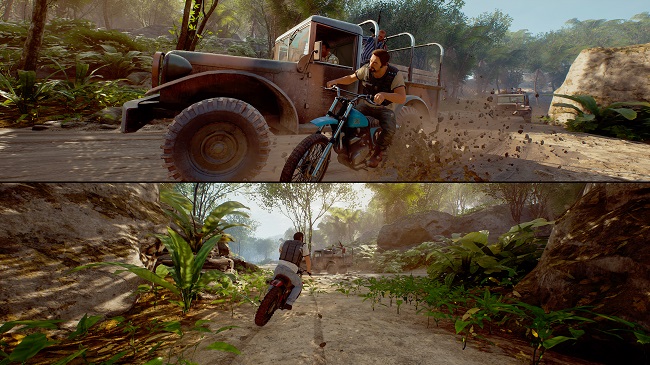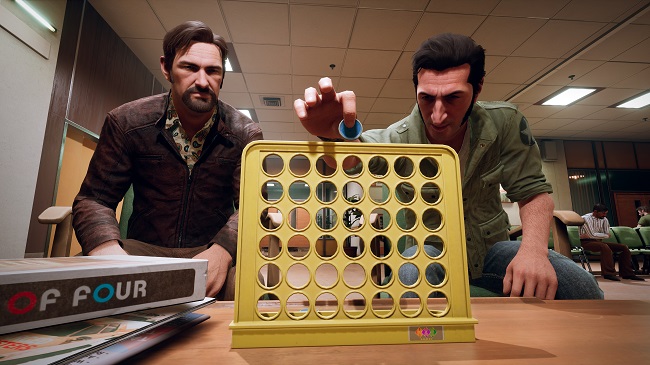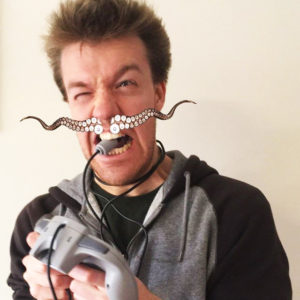
There’s a good chance that you’ve already played A Way out and thought the ending didn’t connect. Maybe it’s because you thought Leo or Vincent could have just shot each other in the leg instead, or perhaps Vincent’s letter was introduced way too late for it to work. If you’re like me, you probably got most irked by the fact that nothing felt different after such an enormous narrative twist. Welcome, fellow irked-person, to the place where I get to vent about the ending while you get to sit there and not vent like a good toy rock. We’ll dissect what happened, why it didn’t work, and revel in one man’s passion for delivering a game that sounded oh so good on paper.
Josef Fares, the Oscar usurper, makes games based around a core idea that’s flipped on its head by some enormous twist. He’s a bit like the Shyamalan of video games right now, and much like the infamous film director, his later work hasn’t been as good as the earlier stuff. While both of Fares’ games have had narrative twists, Brothers’ gameplay reinforced the narrative a hell of a lot better than A Way Out did. To understand why, let’s cast our minds back to Brothers: A Tale of Two Sons.

If you hadn’t figured it out already, there’s going to be a lot of spoilers ahead
The core idea of Brothers is that you control two brothers at the same time. After their father becomes fatally ill, they go on a quest to find a mystical healing fruit to save him, but neither brother can do it alone. You move the taller one with the left stick and the smaller one with the right stick (I’m sure they had names, but who refers to anyone by name anymore?). Contextual actions are relegated to the left or right bumpers corresponding to each brother, and the core gameplay revolved around using both brothers to solve simple puzzles. The twist comes when one of the brothers dies and half of the controls no longer function… Or so you think!
When the younger brother must confront his fear of swimming to reach his father, you must use both sets of controls to swim across a body of water. The beauty of the sequence lies in the reinforcement of the narrative through the core mechanics. The younger brother must accept the passing of the older brother, embracing his memory and using it as his strength to cross the river. If that isn’t a contextual action, I don’t know what is. It’s such a simple yet brilliant idea, and it’s one of the few examples of game mechanics feeding into a narrative that doesn’t suck. A Way Out goes for something similar without needing to lobotomise yourself to move around.

Unless you plan on playing both characters at the same time, you lunatic
Where Brothers had two characters controlled by one person, A Way Out has two players controlling one character each. Each person plays as either Leo or Vincent, but the whole game is played on one screen, even online. Throughout the game, you work together to overcome obstacles that would otherwise be impossible on your own. The big twist is that Vincent is an undercover cop, at which point the game goes from co-op to PvP as our two protagonists duke it out to the death. The split screen nature of the game now represents the synchronicity of the characters, able to understand each other on such a deep level that they know how they think. The dynamic of trust fostered by every previous scene in the game is suddenly torn asunder by this new knowledge, and it’s a pretty good twist, right? Eeeehhhh…
On the face of it, A Way Out’s twist is a substantial reinforcement of the narrative through the mechanics, but it doesn’t work. On the one hand, the players are turned against one another with screen-cheating in mind, and that’s in line with how Leo and Vincent are enemies inside each others’ heads. Beyond that, not much is new. You’re both taking up part of the screen, you both control one of the characters and you’re using the shooting mechanics established in an earlier section. To add insult to injury, when one of the characters dies, their portion of the screen fades to black as the other character fills it. The problem is that we’ve already seen this happen before multiple times, and that’s the key reason why the ending doesn’t work.

We’ve been to Mexico and back. Bit hard to one-up that.
By the time we reach the twist of A Way Out, we’ve already seen everything the game has to offer. We’ve played with guns and mashed buttons for QTE’s, the only difference is the context of those actions. As Penn and Teller would say, it’s the same trick; the setting is the only difference. In Brothers, the core mechanic was flipped on its head, but A Way Out just re-appropriates mechanics for a PvP experience. In my eyes, nothing has changed. I became so used to embracing new mechanics that the changes seen in the last 20-30 minutes of the game felt normal. It’s just another scene you have to play through, and playing against your buddy doesn’t feel as different as it should. Perhaps if the game were more consistent in its gameplay, this wouldn’t be such an issue.
I mentioned in my review that A Way Out feels like a different game every scene, and I meant that. There are no consistent core mechanics, and segments are resembling all sorts of genres, from Street Fighter to Uncharted. While this helps to keep things fresh, it undermines the impact of the ending. Because we’ve already used these mechanics a couple of times, flipping them into PvP mechanics doesn’t feel like a massive leap. In contrast with Brothers, where the controls and mechanics are consistent throughout the game, A Way Out feels like it’s mechanics continuously adapt to the story. Once you reach the climax, the mechanics still can’t decide what they want to be, though it sure as hell knows one of you needs to shoot the other.

My reaction to suddenly having to murder a man
Throughout the game, you are afforded the (illusory) choice of going with Leo or Vincent’s way of doing things. One is messy and violent but will get the job done, and the other is logical, calm and less likely to involve head-butting someone. No matter what you do, the story won’t be impeded because you picked one over the other, but the ending suddenly forces a choice down each player’s throat. The game requires that one of our two protagonists must die. Why? Well, it happens for the sake of drama more than anything else. The fragile veil of autonomy is stripped from the players in the name of an almost laughably operatic ending. Honestly, it wasn’t a great idea to go so heavy on the drama when you’re playing with your friend.
Because A Way Out is played with a buddy, the challenge of making us want to go from playing together to against one another in any serious fashion is almost impossible. The shift feels more like you’re playing your own game and the other player is there for the ride. It’s vaguely competitive, but there’s nothing to show how we’re going against each other (unless you count the health bars at the bottom, but that becomes irrelevant anyway). This isn’t Quake; we don’t have a scorecard to keep track of our relative skill, it’s a matter of pinging the other guy occasionally because we have no other choice. More than likely, we’ll still talk to each other, laugh at how the facial animations suck and be jovial when the game asks us to be sombre. Of course, this doesn’t mean the core idea is irredeemable.

From having to stabbing each other’s backs
Just because the ending didn’t work doesn’t mean I hated the idea behind it. Looking past the poor writing and lacklustre usage of mechanics, switching from co-op to PvP is an interesting premise. You’ve got to build up trust between the players, but you know that you’ll be breaking them apart later down the line. The thing is, the players aren’t going to put down the game just because you pitted them against one another, especially if they’ve already invested some time into the game. So, how could A Way Out have pulled off its ending? Well, as someone arrogant enough to think he can design a better game than Hazelight, let’s start with the timing of the twist.
If we’re going to think about succeeding in the shift from co-op to PvP, we’ll start by unveiling Vincent’s past earlier in the game. Rather than an abrupt section that lasts 20 minutes, we need a PvP section with a bit more meat to it. This needs to change how the players interact with one another fundamentally, and relegating such violent upheaval to the last 5% of your game is pretty lame. I want to see the results of this conflict, I want to see character reactions, and surely we can bring old characters back for more than one scene. This is the exciting bit, and it’s the bit where we can subvert some expectations.

We need to crank it up to Monopoly levels of rivalry
The other reason we pull this twist forward is to avoid any issues with player predictions. Kyle, the guy I played A Way Out with, had the ending figured out before we’d even escaped prison, but the problem wasn’t that he was right. His first impressions, the things that people will cling to like bad ideas at a hackathon, were validated at the very end of the game. It’s not a very interesting story if you can see the ending coming from the first few minutes, so we have to keep people like Kyle on their toes. So, we pull the twist forward and figure out what happens next, but this is where things get tricky.
How do you make a PvP split-screen experience that doesn’t rely on shooting one another? Well, there’s hide and seek, chase sequences and plenty of other cinematic scenes to choose from, but what exactly we do isn’t as important as the feelings we want to cultivate in the players. We need to go from a level playing field to positions of power, because if there’s one way to get people to hate each other, it’s giving one of them more power than the other. Inequality is the name of the game, and swapping who has the power throughout the finale is crucial to making sure players stay invested. Perhaps more than anything, now is the time to leverage the two-screen format of the gameplay.

You know, that gimmick that we’ve been using since the start of the game?
The core idea of the game is that you see both screens at all times, so let’s do a bit more with that than one screen-cheating section. We want to make it evident that one of our characters has an advantage, and what better way than showing them both sides of the scenario? Leo wants to see his wife, but Vincent’s already talking with her and keeping backup out of sight. Vincent’s revisiting the building where his brother died, but Leo’s waiting for him in the shadows. These scenarios utilise the dual-screen nature of the game while feeding into the narrative idea that these guys know each other inside and out. Exploring the gameplay of this section is a lot more interesting than the typical co-op we’ve seen up to this point, and it’s a shame Hazelight cut it short with a shootout.
A Way Out’s ending sucked on multiple levels. It was a cliché direction that lasted all of 20 minutes and didn’t utilise the game’s mechanics in any meaningful way. Compared to Josef Fares’ previous game, Brothers, it’s a bungled effort that doesn’t seem to capitalise on the mechanics it has to work with. It’s an exciting idea at its core, but the execution doesn’t stick the landing. The twist wasn’t narratively great either, but hey, you have to give Josef Fares credit for trying something more interesting than anything Telltale’s done in the last five years.











